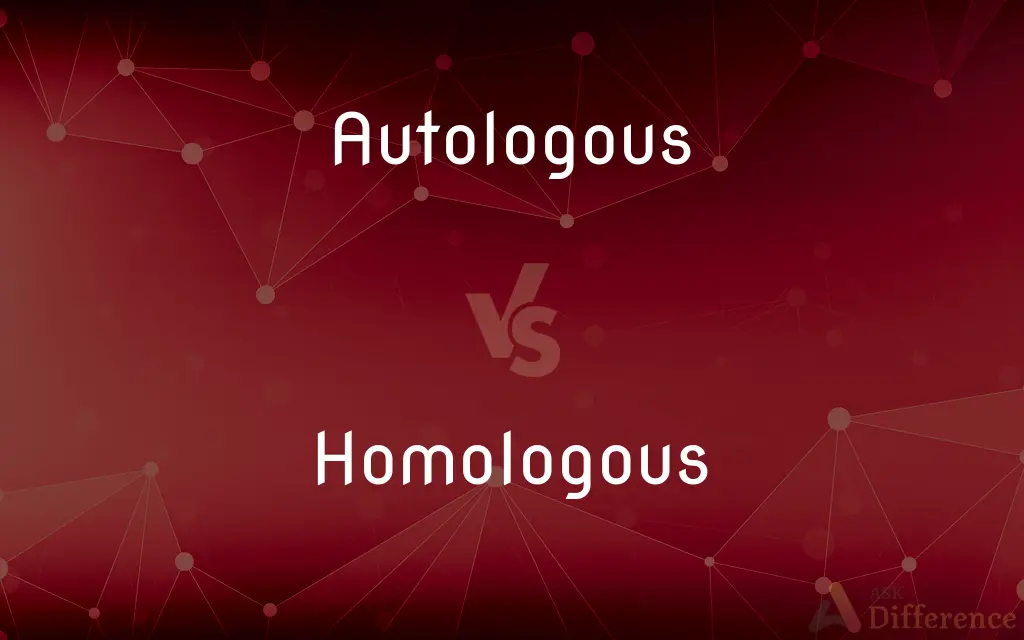Autologous vs. Homologous — What's the Difference?
By Fiza Rafique & Maham Liaqat — Updated on April 24, 2024
Autologous processes involve the use of a person's own tissues or cells, ensuring high compatibility; homologous, on the other hand, involves materials from a genetically similar donor, increasing the risk of rejection.

Difference Between Autologous and Homologous
Table of Contents
ADVERTISEMENT
Key Differences
Autologous treatments use a patient’s own biological materials, such as blood or bone marrow, minimizing immune rejection. Whereas, homologous treatments involve the use of materials from another individual who is genetically similar but not identical, such as a sibling, which can carry a higher risk of immune response.
Autologous therapies are often employed in medical fields like regenerative medicine and plastic surgery, where self-donated tissues or cells are reintegrated into the patient's body. On the other hand, homologous therapies are common in situations like blood transfusions or organ transplants from compatible donors.
In terms of safety and compatibility, autologous approaches are typically preferred due to the reduced likelihood of complications related to immune rejection. Whereas, homologous approaches require careful donor matching and immunosuppression to prevent rejection.
The preparation time for autologous therapies can be longer and more complex, as it involves harvesting and processing the patient's own biological materials. Meanwhile, homologous treatments can be quicker to initiate, as they utilize readily available donor tissues or cells.
Autologous treatments can be more expensive due to the personalized nature of harvesting and preparing a patient’s own cells. In contrast, homologous treatments may be less costly but come with increased logistical needs for donor matching and management.
ADVERTISEMENT
Comparison Chart
Source of Material
Patient’s own cells or tissues
Genetically similar donor
Immune Rejection Risk
Low
Higher due to genetic differences
Common Uses
Regenerative medicine, plastic surgery
Blood transfusions, organ transplants
Preparation Time
Longer, involves harvesting patient's cells
Quicker, uses pre-donated materials
Cost and Logistics
More expensive, personalized treatment
Less expensive, complex donor coordination
Compare with Definitions
Autologous
Pertaining to material derived from the same individual’s body.
Autologous blood donation is often done in preparation for surgery.
Homologous
In genetics, relating to chromosomes with a similar structure and gene sequence.
Homologous chromosomes pair up during meiosis.
Autologous
Using one’s own biological materials for therapeutic purposes.
Autologous fat grafting is popular in reconstructive surgery.
Homologous
Involving the donation of tissues or cells between genetically similar individuals.
Homologous bone marrow transplants require a compatible donor.
Autologous
Involving one's own cells, especially in medical treatments.
Autologous stem cell transplants are used in treating certain cancers.
Homologous
Describing organs or structures that are similar in position and evolutionary origin.
Homologous structures in different animals highlight evolutionary relationships.
Autologous
Derived from an organism's own tissues or DNA.
Autologous skin grafts are preferred for their compatibility.
Homologous
Relating to the replacement of body parts or fluids from a similar donor.
Homologous skin grafts are second to autologous options due to rejection risks.
Autologous
Being a word that possesses the characteristic it describes, such as short.
Homologous
Corresponding or similar in position, value, structure, or function.
Autologous
Derived from part of the same individual (i.e. from the recipient rather than a different donor).
Homologous
Derived from the same species
A homologous graft.
Homologous
(Biology) Similar in structure and evolutionary origin, though not necessarily in function, as the flippers of a seal and the hands of a human.
Homologous
(Immunology) Relating to the correspondence between an antigen and the antibody produced in response to it.
Homologous
Relating to chromosomes that have the same morphology and linear sequence of gene loci.
Homologous
Relating to genes that are derived from a common ancestor.
Homologous
(Chemistry) Belonging to or being a series of organic compounds, each successive member of which differs from the preceding member by a constant increment, especially by an added CH2 group.
Homologous
Showing a degree of correspondence or similarity.
Homologous
(mathematics) In corresponding proportion.
Homologous
(biology) Corresponding to a similar structure in another life form with a common evolutionary origin.
Flippers and hands are homologous structures.
Homologous
(chemistry) Belonging to a series of aliphatic organic compounds that differ only by the addition of a CH₂ group.
Homologous
(genetics) Having the same morphology as another chromosome or locus; relating to a homologue.
Homologous
Playing the same role as seen in another culture, whether by historical connection, psychological archetype, convergent cultural evolution, or otherwise (as may be hypothesized but not known with certainty by current science), as for example with the cryptozoologic concepts of yeti and sasquatch, the use of polite and familiar pronouns, or other similarities.
Homologous
Having the same relative position, proportion, value, or structure.
In similar polygons, the corresponding sides, angles, diagonals, etc., are homologous.
Homologous
Having the same relative proportion or value, as the two antecedents or the two consequents of a proportion.
Homologous
Having the same evolutionary origin but serving different functions;
The wing of a bat and the arm of a man are homologous
Homologous
Corresponding or similar in position or structure or function or characteristics; especially derived from an organism of the same species;
A homologous tissue graft
A heterologous graft
Common Curiosities
Are autologous treatments more expensive than homologous treatments?
Yes, autologous treatments are typically more expensive due to the personalized process.
Why might one choose a homologous treatment instead of an autologous one?
Homologous treatments can be more readily available and less time-consuming to prepare.
Can homologous treatments be used for genetic disorders?
Yes, they are particularly useful in cases where a genetic match is critical, such as bone marrow transplants.
In what scenarios are homologous treatments preferred over autologous treatments?
Homologous treatments are often preferred when immediate treatment is necessary and there is no time to harvest and prepare autologous materials, or when the patient's condition does not allow for autologous harvesting.
What advancements are being made in autologous therapy research?
Research in autologous therapies is advancing in areas like stem cell treatments and tissue engineering, aiming to treat a wider range of conditions more effectively.
What is the main advantage of autologous treatments?
Autologous treatments minimize the risk of immune rejection.
Are there ethical considerations unique to homologous treatments?
Yes, homologous treatments involve ethical considerations related to donor consent, privacy, and the management of donor-related risks.
What types of medical conditions benefit most from autologous treatments?
Autologous treatments are particularly beneficial for conditions requiring tissue regeneration, such as burns or complex orthopedic issues.
What are the risks associated with autologous treatments?
While generally safe, autologous treatments carry risks such as infection at the extraction site or complications from anesthesia during collection of cells or tissues.
What role do genetics play in the effectiveness of homologous treatments?
Genetics play a crucial role in the effectiveness of homologous treatments; a closer genetic match between donor and recipient reduces the risk of complications.
How do logistical challenges differ between autologous and homologous treatments?
Logistical challenges for autologous treatments include the need for specialized facilities and time to process patient-derived materials. Homologous treatments require robust systems for donor management and tissue matching.
How do autologous treatments impact the immune system compared to homologous treatments?
Autologous treatments typically have minimal impact on the immune system as they use the patient’s own cells, reducing the likelihood of immune reactions. Homologous treatments, however, may require immune suppression to prevent rejection.
Can homologous treatments be used for cosmetic purposes?
Yes, homologous treatments such as fat grafting or collagen injections from donors are occasionally used for cosmetic enhancements.
Share Your Discovery

Previous Comparison
Remodeling vs. Remodelling
Next Comparison
Arian vs. AryanAuthor Spotlight
Written by
Fiza RafiqueFiza Rafique is a skilled content writer at AskDifference.com, where she meticulously refines and enhances written pieces. Drawing from her vast editorial expertise, Fiza ensures clarity, accuracy, and precision in every article. Passionate about language, she continually seeks to elevate the quality of content for readers worldwide.
Co-written by
Maham Liaqat















































